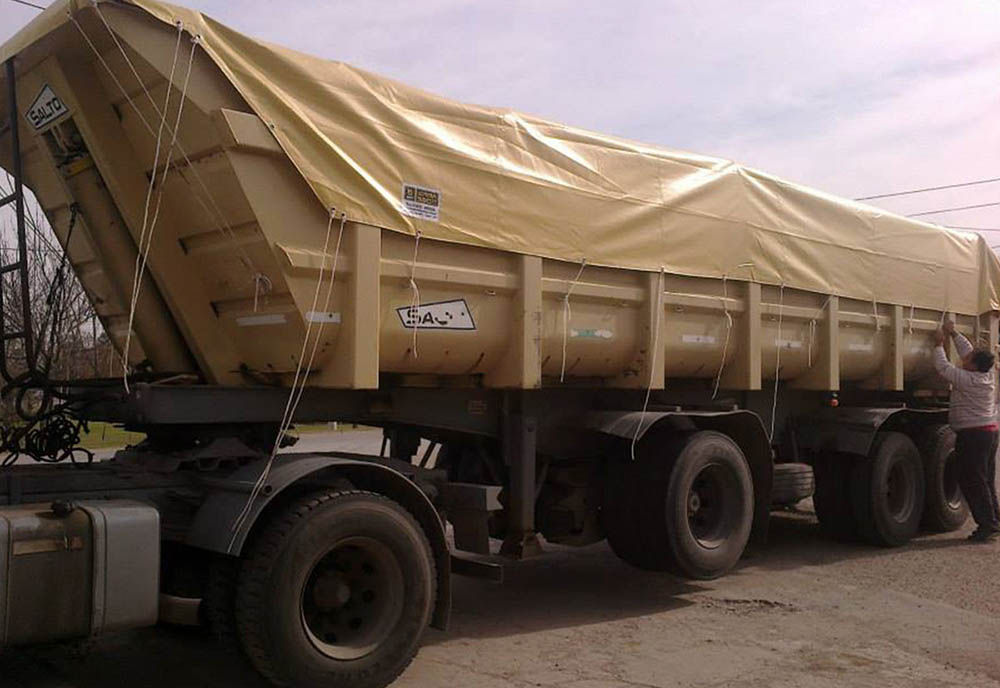PVC tarpaulin fabric has revolutionized cargo protection in the transportation sector, offering unparalleled durability and adaptability.
This guide delves into its engineering properties, industry applications, material superiority, and selection protocols to equip fleet managers and logistics professionals with actionable insights.
Features of PVC Tarpaulin for Trucks
UV Stabilization
Advanced UV inhibitors are chemically bonded to the PVC matrix, achieving a UPF 50+ rating that blocks 98% of UV radiation.
This prevents polymer chain scission, maintaining tensile strength and colorfastness for over 10,000 exposure hours in desert or tropical climates.
Tensile and Tear Resistance
Interwoven high-tenacity polyester yarns (1000-1500 Denier) with PVC lamination create a warp/weft strength of 3500/3000 N/5cm, exceeding ISO standards.
The cross-laminated structure resists progressive tearing, critical when securing irregular loads like steel coils.
Waterproofing
Through a dual-stage coating process (primer + topcoat), PVC tarps achieve a 20,000mm hydrostatic head rating, surpassing EN 15619 requirements for heavy-duty truck covers.
The seamless surface tension prevents capillary action, ensuring zero moisture ingress even at 60° tilt angles.
Thermal and Chemical Stability
Stabilized with organotin compounds, PVC tarps maintain flexibility from -30°C to +70°C. They resist hydrolysis from acids, diesel spills, and hydraulic fluids.
Life Optimization
Accelerated aging tests confirm 6-8 years service life with proper maintenance. Anti-fungal additives prevent biofilm formation in humid environments.
Common Applications of PVC Tarpaulin for Trucks
Flatbed Cargo Securement Systems
Construction Sector: Protects prefab concrete panels from efflorescence-causing moisture.
Wind Energy: Custom-fitted covers for turbine blades during road transport
Military Logistics: Certified tarps for armored vehicle transit.
Dock Environmental Control
Cold Chain Logistics: Thermal-break designs with R-values up to 1.5 for refrigerated dock doors.
Dust Suppression: Electrostatic discharge models prevent particulate adhesion in pharmaceutical loading zones.
Specialized Vehicle Protection
Mining Trucks: Abrasion-resistant variants (Taber test >10,000 cycles) for ore transport.
Agricultural Haulers: Methane-resistant formulations for livestock carriers.
Ancillary Truck Components
Cab Spoilers: Aerodynamic PVC covers reducing drag by 12%.
Load-Bearing Curtains: Reinforcement bars enable 2:1 safety factors for vertical side curtains.
Why PVC Coated Tarpaulin is the Best Choice
Polymer Engineering Advantages
PVC's amorphous structure allows precise plasticizer tuning for cold-flex performance.
The glass transition temperature is optimized between -15°C to -25°C to prevent brittle fracture.
Coating Technology Breakthroughs
Modern calender-coating lines apply 800-1200 gsm PVC layers with:
Release Coatings: Silicone-treated surfaces prevent cargo adhesion.
Anti-Graffiti Layers: Solvent-resistant topcoats enable pressure-washing up to 1500 PSI.
Performance Benchmarking
Comparative data against alternatives:
| Property | PVC Tarp | PE Tarp | Canvas |
| Tensile Strength | 3500 N/5cm | 800 N/5cm | 1200 N/5cm |
| Water Resistance | 20,000mm | 5,000mm | Not rated |
| UV Life | 6-8 years | 2-3 years | 1-2 years |
How to Choose the Right PVC Tarpaulin
Material Specification Checklist
Base Fabric
Yarn Type: High-modulus polyester
Weave Density: 18x18 threads/cm² minimum
Coating Parameters
PVC Layer: ≥0.45mm with UV stabilizers
Adhesion: ≥4 N/cm
Performance Certifications
EN 15619 (Truck Covers)
NFPA 701 (Flame Spread)
REACH SVHC Compliance
Supplier Qualification Process
Audit coating facilities for ISO 9001:2015 certification
Require batch test reports
Validate seam welding techniques
Total Cost of Ownership Analysis
Factor in
Replacement Interval: PVC vs. PE cost over 10 years
Fuel Efficiency: Aerodynamic covers save 3-5% diesel consumption
Insurance Premiums: Reduced cargo damage claims
Click here to browse our PVC Coated Truck Cover Tarpaulin































